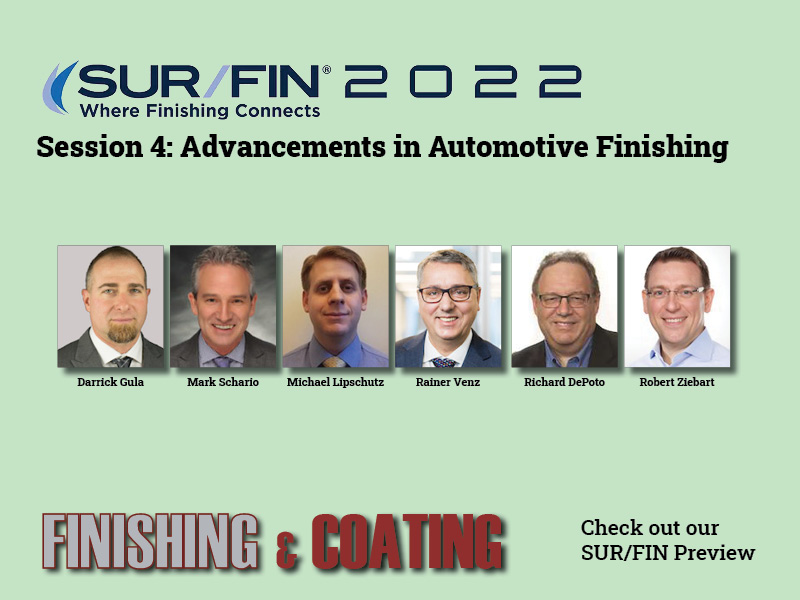Session 4 at the NASF SUR/FIN Technical Conference will be on “Advancements in Automotive Finishing.”
Here are the abstracts for the presentations on June 7. Please visit www.nasfsurfin.com for information on registering for the event:
Session 4: Advancements in Automotive Finishing
Session Chairs Ling Hao, Lacks Enterprises, and Adam Blakeley, MacDermid Enthone
1:30 – 2:00: How to Navigate Your Future Product Finishing Business Planning to Prepare for the EV Revolution — Darrick Gula, Atotech USA
 Darrick GulaFor the past couple of years there has been so much attention and discussion on the change in the automotive industry. Mainly about the shift from ICE to EV technology. It seems like every month a new OEM talks about the all-electric future. While the debate can continue how fast this change will be implemented, one thing is for sure, this change is real. How this will impact the product finishing community is on the minds of many of us in the industry. While the change will affect us in many ways, from elimination/reduction of ICE components requiring plating/coatings, to changing designs that eliminate bright chrome finishes, there will be new areas for growth and technology development. We will explore the changing landscapes and touch on new technologies and opportunities the EV revolution will provide. What areas of the automotive production are at risks and what areas can quickly grow and provide a sustainable future business plan? With many OEMs the change is coming fast and new EV technology must be developed quickly. This exposes many areas of technology that is currently not completely understood or properly integrated. Our industry must be flexible to adapt to these changes and become a leader in development of the new technologies.
Darrick GulaFor the past couple of years there has been so much attention and discussion on the change in the automotive industry. Mainly about the shift from ICE to EV technology. It seems like every month a new OEM talks about the all-electric future. While the debate can continue how fast this change will be implemented, one thing is for sure, this change is real. How this will impact the product finishing community is on the minds of many of us in the industry. While the change will affect us in many ways, from elimination/reduction of ICE components requiring plating/coatings, to changing designs that eliminate bright chrome finishes, there will be new areas for growth and technology development. We will explore the changing landscapes and touch on new technologies and opportunities the EV revolution will provide. What areas of the automotive production are at risks and what areas can quickly grow and provide a sustainable future business plan? With many OEMs the change is coming fast and new EV technology must be developed quickly. This exposes many areas of technology that is currently not completely understood or properly integrated. Our industry must be flexible to adapt to these changes and become a leader in development of the new technologies.
2:00 – 2:30: Decorative Plating: Identifying Testing Standards — Mark Schario, Columbia Chemical
 Mark ScharioRegulatory pressure and innovation in surface finishing continue to drive the industry toward trivalent decorative chrome plating and away from hexavalent. Due to the upsurge in usage of trivalent chromium and its unique alloy properties, ASTM has identified the need for thickness testing standards. As Chairman for ASTM B08.10 Subcommittee on Test Methods for Metallic and Inorganic Coating, Mark Schario is leading the committee’s focus on developing standardized testing for trivalent chrome thickness. This presentation will provide an update on this initiative, review the test methods and variables selected, and report on the testing data collected thus far.
Mark ScharioRegulatory pressure and innovation in surface finishing continue to drive the industry toward trivalent decorative chrome plating and away from hexavalent. Due to the upsurge in usage of trivalent chromium and its unique alloy properties, ASTM has identified the need for thickness testing standards. As Chairman for ASTM B08.10 Subcommittee on Test Methods for Metallic and Inorganic Coating, Mark Schario is leading the committee’s focus on developing standardized testing for trivalent chrome thickness. This presentation will provide an update on this initiative, review the test methods and variables selected, and report on the testing data collected thus far.
2:30 – 3:00: High Throw, High Levelling, Low Stress Acid Copper Electroplating Process — Dr. Michael Lipschutz, DuPont Electronics and Industrial
 Michael LipschutzElectrolytic copper is applied to almost every decorative and functional metallized plastic part, providing high brightness, levelling out imperfections from the plastic molding process, and serving as the deposit upon which all subsequent finishing steps are built. For decades, the most common copper process has utilized a dye-based brightening system because it is inexpensive and produces a bright, levelled finish. However, this system has some significant drawbacks. The deposits produced by the dye-based process are highly stressed and have poor ductility, which significantly affects the reliability of parts plated using many of the new hex-chrome-free etching processes. The process also has very low throwing power, requiring significant over-plating in some areas to achieve the minimum thickness across the entire part, wasting considerable amounts of metal and equipment time. To address these challenges, DuPont Electronics & Industrial has developed ECOPOSITTM 95HT High Throw Electrolytic Copper, a new electrolytic copper plating process with a novel brightening system. This new system has significantly improved throwing power and produces deposits with highly improved stress and ductility. This talk will review the technical aspects of the process, the deposit, and highlight the benefits it affords when utilizing chrome-free etching processes.
Michael LipschutzElectrolytic copper is applied to almost every decorative and functional metallized plastic part, providing high brightness, levelling out imperfections from the plastic molding process, and serving as the deposit upon which all subsequent finishing steps are built. For decades, the most common copper process has utilized a dye-based brightening system because it is inexpensive and produces a bright, levelled finish. However, this system has some significant drawbacks. The deposits produced by the dye-based process are highly stressed and have poor ductility, which significantly affects the reliability of parts plated using many of the new hex-chrome-free etching processes. The process also has very low throwing power, requiring significant over-plating in some areas to achieve the minimum thickness across the entire part, wasting considerable amounts of metal and equipment time. To address these challenges, DuPont Electronics & Industrial has developed ECOPOSITTM 95HT High Throw Electrolytic Copper, a new electrolytic copper plating process with a novel brightening system. This new system has significantly improved throwing power and produces deposits with highly improved stress and ductility. This talk will review the technical aspects of the process, the deposit, and highlight the benefits it affords when utilizing chrome-free etching processes.
3:00 – 3:30: Maximizing Performance of EV’s Through Material Selection and Quality Control — Rainer Venz, ESI Automotive
 Rainer VenzEV performance has evolved and improved rapidly over the last 5 years. Over this period consumers have held back from EV adoption due to a number of anxieties, such as vehicle range, charging time and availability and reliability. Car makers are trying to optimize the subsystems with regard to cost, performance and continued differentiation. The materials used in EV Batteries, inverters, motors and in radar and vision systems for advanced driver assistance systems (ADAS) have a significant and measurable impact on the cars performance. Optimized material choices in combination with QPS systems (Quality and Performance Systems,) will assist to optimizing hardware to meet and exceed the reliability requirements and to avoid or reduce the number of vehicle recalls.
Rainer VenzEV performance has evolved and improved rapidly over the last 5 years. Over this period consumers have held back from EV adoption due to a number of anxieties, such as vehicle range, charging time and availability and reliability. Car makers are trying to optimize the subsystems with regard to cost, performance and continued differentiation. The materials used in EV Batteries, inverters, motors and in radar and vision systems for advanced driver assistance systems (ADAS) have a significant and measurable impact on the cars performance. Optimized material choices in combination with QPS systems (Quality and Performance Systems,) will assist to optimizing hardware to meet and exceed the reliability requirements and to avoid or reduce the number of vehicle recalls.
3:30 – 4:00: Colored Aluminum Surfaces as Automotive Fashion Finish — Sascha Wegner, MacDermid Enthone
 Sascha WegnerElectro-coloring processes have been widely used in the architectural industry for many decades. This process of choice exhibits unsurpassed lightfastness for exterior applications and offers a range of colors that can be achieved. By varying the metal ions of the electro-coloring process, color tones from stainless steel, light to dark bronze, copper and true blacks can be achieved. Although these processes seem to be well understood, the finish requirements in the automotive industry are different and continuously changing. High gloss surfaces and pH resistant finishes have been becoming the norm for the automotive industry and pose challenges for applicators. This presentation will illustrate the various influence factors on color tones and gloss levels of the final finish. It will demonstrate how quality consistency is achievable by optimizing pretreatment, anodizing, electro-coloring and sealing parameters. Besides the traditional silver and black finishes, newly developed electro-coloring process can extend the range of lightfast colors for exterior automotive applications and provide additional design opportunities.
Sascha WegnerElectro-coloring processes have been widely used in the architectural industry for many decades. This process of choice exhibits unsurpassed lightfastness for exterior applications and offers a range of colors that can be achieved. By varying the metal ions of the electro-coloring process, color tones from stainless steel, light to dark bronze, copper and true blacks can be achieved. Although these processes seem to be well understood, the finish requirements in the automotive industry are different and continuously changing. High gloss surfaces and pH resistant finishes have been becoming the norm for the automotive industry and pose challenges for applicators. This presentation will illustrate the various influence factors on color tones and gloss levels of the final finish. It will demonstrate how quality consistency is achievable by optimizing pretreatment, anodizing, electro-coloring and sealing parameters. Besides the traditional silver and black finishes, newly developed electro-coloring process can extend the range of lightfast colors for exterior automotive applications and provide additional design opportunities.
4:00 – 4:30: Next Generation Silver Alloys with Improved Properties for Automotive and Industrial High Power Connectors — Richard DePoto, Robert Ziebart, Umicore Galvotechnik GmbH/Uyemura International
 Richard Depoto and Robert ZiebartThe paper will introduce new silver alloys and their improved properties as functional and alternative coatings. The paper compares these alloys to the established coatings such as hard gold and palladium-nickel with flash gold in E-Mobility and High Power industrial applications. Gold and palladium have been used long time as contact materials for technical surfaces. Due to rising precious metal prices, silver and silver alloys are increasingly coming into focus to replace these coatings. The goal is to review the status of current development of various silver alloys and their competitive properties vs. the disadvantages of pure silver coatings. Especially under the aspect of long-term stability, these new silver alloys show their real potential. In hardness, stable contact resistance and tri-biological properties which remain consistent over long term even at elevated temperatures. Requirements such as end-of-life in the automotive sector are covered in an exemplary manner. For e.g. an innovative silver dispersion electrolyte and plated layers out of it have similar electric properties like a pure silver coating but offering a very low COF and no tendency for galling. These are properties that a pure silver coating can’t offer. Additionally, if we look into a silver palladium alloy, which has competitive properties vs hard gold or palladium-nickel we add the benefit of a cyanide free process. Silver alloys are already used and established in industrial and automotive electronics, but with limitations in the field of electroplating, especially for R2R plating of connectors, which this paper will also briefly review. In summary, silver alloys and their advantageous properties open up options to be used as an alternative functional coating for existing connector applications as well as opportunities in other industries such as high power applications, the next generation of e-mobility and high power industrial connectors.
Richard Depoto and Robert ZiebartThe paper will introduce new silver alloys and their improved properties as functional and alternative coatings. The paper compares these alloys to the established coatings such as hard gold and palladium-nickel with flash gold in E-Mobility and High Power industrial applications. Gold and palladium have been used long time as contact materials for technical surfaces. Due to rising precious metal prices, silver and silver alloys are increasingly coming into focus to replace these coatings. The goal is to review the status of current development of various silver alloys and their competitive properties vs. the disadvantages of pure silver coatings. Especially under the aspect of long-term stability, these new silver alloys show their real potential. In hardness, stable contact resistance and tri-biological properties which remain consistent over long term even at elevated temperatures. Requirements such as end-of-life in the automotive sector are covered in an exemplary manner. For e.g. an innovative silver dispersion electrolyte and plated layers out of it have similar electric properties like a pure silver coating but offering a very low COF and no tendency for galling. These are properties that a pure silver coating can’t offer. Additionally, if we look into a silver palladium alloy, which has competitive properties vs hard gold or palladium-nickel we add the benefit of a cyanide free process. Silver alloys are already used and established in industrial and automotive electronics, but with limitations in the field of electroplating, especially for R2R plating of connectors, which this paper will also briefly review. In summary, silver alloys and their advantageous properties open up options to be used as an alternative functional coating for existing connector applications as well as opportunities in other industries such as high power applications, the next generation of e-mobility and high power industrial connectors.
4:30 – 5:00: Waste Water Treatment in Today’s World — Jim Collins, Brenntag Mid-South
In the metal finishing world many suppliers have had to reformulate the finished product needed in the surface finishing facility, because they cannot get adequate supply of chemistry that has worked for years - due to the supply chain shortage. The reformulation of these chemistries has caused problems in waste water treatment. The specialty chemical suppliers have had to use different surfactants, chelants, brighteners and mineral sequestrants. This fact has caused the surface finishing facilities to change coagulants, flocculants and precipitants.



































